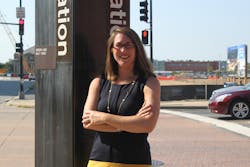2015 Top 40 Under 40: Jamie D. Pfister
Jamie D. Pfister
Deputy Associate Administrator; Office of Research, Demonstration, and Innovation
Federal Transit Administration/U.S. Department of Transportation
- Alma Mater: Georgia Institute of Technology and Georgia State University
- Fun Fact: The first public transportation systems she rode was in Guam, at age 3, unaccompanied by parents, to preschool
- Favorite Book: She can’t remember the last time she read a book that wasn’t about parenting or leadership
- Favorite TV Show: House of Cards
- Favorite Movie: Love Actually
- Favorite Hobbies: Spending as much time with family as possible — immediate and extended family
One misfortune turned into good fortune for Jamie Pfister when she lost a job in the telecom industry in the 2001 recession. She was an engineer, talked to some people in the engineering group at the Federal Transit Administration (FTA) and applied to several vacancy announcements. Her application got lost, but several months later received a call for an interview for a position in Atlanta.
She entered the Atlanta office as a junior engineer and was recently appointed deputy associate administrator of Research, Development and Innovation. For the last four years, Pfister was the director of the Office of Transit Programs at FTA headquarters.
In that position, Pfister was directly responsible for ensuring the effective implementation of FTA’s $10 billion grant program. All of the programs received substantial modification in the latest authorization, MAP-21 and required close coordination and outreach with senior FTA and U.S. Department of Transportation (DOT) staff, as well as transit agencies, state and local governments, and industry stakeholders.
Additionally, she has managed the development of new grant making guidance to the regions, has coordinated the technical efforts of updating program Circulars for each of these programs, which provide detailed guidance to FTA grantees, and developed and held outreach and training to both FTA staff and grantees.
During this period where MAP-21 implementation was expected to be the focus of her work efforts, Hurricane Sandy struck, causing major devastation to public transportation systems in the New York and New Jersey area. Although MAP-21 created the new Emergency Relief Program, no guidance or program requirements yet existed by which FTA could allocate the $10.9 billion Congress quickly appropriated for this program. As the Emergency Relief program is part of the Office of Transit Programs, her efforts have been crucial to standing up this new program. She worked to quickly publish a Notice of Emergency Funding Availability, supported the development of an Interim Final Rule, developed grant-making guidance to the regional offices, and oversaw the funds allocation process. It is hard to understate how rapidly these processes were completed for such a unique program. These activities required close coordination with senior FTA officials and with other FTA offices such as the Office of Chief Counsel, the Office of Budget and Policy, and the Region 2 Office in New York. Her leadership has been invaluable in standing up the program and FTA was quickly able to allocate the first $2 billion of funding within 60 days as required by Congress.
Pfistser has consistently partnered with industry groups such as the American Public Transportation Association (APTA), American Association of State Highway and Transportation Officials (AASHTO), and the Community Transportation Association of America (CTAA) to ensure that FTA is developing technical assistance and delivering outreach on issues of critical importance to the industry
“For years thought I would go into the hospitality industry just because of my passion of being able to be a people pleaser — make sure they’re happy and that their needs are met. Working in public transit, every day you have the opportunity to help someone.
“We give the money to [transit operators], but at the end of the day, we do the policies and regs and requirements on how to use the money, but the providers that are being able to meet everybody’s mobility needs, whether it’s a senior service or an individual with disabilities or just the general public, we’re having an impact on the lives of millions of people.
“I just can’t imagine working somewhere and going to work every day where I wasn’t having an impact on a huge reach around the country.”
“I’ve been with FTA 13 years and I would say all but maybe 1, we’ve had funding challenges which make it very difficult to plan. We’re having difficulty, which means all the way down to the local level, it’s very difficult to do these infrastructure improvements that are needed.”
“How do we ensure that public transit is an equal mode of choice or a preferred option and is part of a suite of options, if you will? A reliable, preferred option among many, many mobility choices that people have today. We see so many modes, it’s not just bus and rail … it really is a shared-use environment.
“I think that in addition to the age-old problem of reliable funding and committed funding, we also have this need to look at how we can innovate — innovation without money. I think we need to think about that because you want to make sure public transit stays a viable preferred option for people amongst what’s becoming many options in the transportation arena.”
